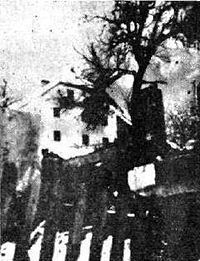Jože Gregorčič Willi Hertlein | Dates 9 Jan 1942 – 11 Jan 1942 | |
 | ||
200 fighters 4000 policemen and soldiers Similar World War II, Battle of Turjak Castle, Operation Mihailovic, Battle of Loznica, Operation Alfa | ||
The Battle of Dražgoše (Slovene: dražgoška bitka) was a Second World War battle between the Slovene Partisans and Nazi Germany armed forces, which took place between January 9 and January 11, 1942, in the village of Dražgoše (nowadays Slovenia). This battle was the first direct confrontation between the two. It ended with brutal reprisals of German forces against the villagers and the destruction of the village.
Contents
The battle
Fighting (both numerically and equipment-wise) vastly superior Germans the Partisan Cankar Battalion (numbering 240 combatants) suffered eight casualties throughout the entire battle. German forces suffered 26 casualties according to German documents. After three days of fighting, the Partisans were forced to leave the village. After the battle, the Partisans were pursued and killed by the Germans.
More recent publications have cast the events in a different light, stating that the Partisans selected Dražgoše as a scene to challenge the German forces. The villagers asked the Partisans forces to leave the village, but they refused; then, when the German forces attacked, the Partisans fled. According to Corsellis and Ferrar, the Partisans believed that uprisings such as the one at Dražgoše and the resulting reprisals turned the population against the Germans. The Catholic populace considered that the Partisans staged such uprisings in or near Catholic villages deliberately so that Catholics would be targeted by reprisals.
Aftermath
German troops executed 17 male civilians immediately upon having secured a portion of the village. During the evening of the following day, a further 18 male residents who had previously escaped, only to be apprehended as they returned were executed, houses were looted and the village was set on fire. When the fires died down, the Germans then demolished the entire village. The remaining villagers were then rounded up and sent to concentration camps. After the war, the village was entirely rebuilt.
Two days after this engagement, German troops attacked two partisan platoons on the Mošnje Pasture (Mošenjska planina). During the 13-hour engagement, some 12 Partisans were killed and 5 were wounded.
Interpretations
On the one hand, the Battle of Dražgoše was lauded as a heroic act of defiance during the Communist era. It was also highly praised after Slovenia declared independence and introduced democracy. Danilo Türk, the president of Slovenia, described the Battle of Dražgoše as the "biggest moral victory" of the Slovene nation and as the "victory of responsibility for the future of one's own nation" in 2008. He stated that it was a foundation for Slovenia as an independent country.
On the other hand, due to the sources that narrate a story about how the Partisans cynically used the village, the political analyst Boštjan M. Turk characterised the Battle of Dražgoše as a great suffering of the Slovenian nation and a disgrace for the Partisan movement; it has also been characterized as a "wasted effort." According to Turk, "Dražgoše represents a major defeat of the will and spirit of the resistance against the Nazis because innocent people paid for the Partisan hoax with their lives." From the Communist point of view, Dražgoše was not a failure because it raised fear among people and made carrying out the revolution and the conquest of power much easier. The historian Stane Granda has described the Battle of Dražgoše as a "catastrophic miscalculation" and the "devastation of the village of Dražgoše", and its contemporary national celebration as an "ideological and political construction".
